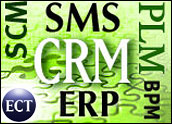
Home-grown ERP systems are the Oscar Madisons of the IT world. Grizzled by years of service yet reluctant to change, these massive home-grown systems resist the efforts of CIOs to transform them. More often than not, the home-grown ERP system ends up changing the CIO. The complexity and lack of clarity makes some CIOs yearn for hosted applications to increase responsiveness.
Hosted channel, CRM and analytics initiatives are showing usability improvements and offering alignment of work flows. Best of all, they can be turned on and off like a utility. Several of these applications have streamlined interfaces, forsaking the “more is better” mantra of previous CRM applications. This extreme makeover hosted CRM applications are getting would satisfy Felix Unger on even his most perfectionist days.
Legacy ERP
Legacy ERP systems change gradually, shifting emphasis only as the company’s business model requires extensions to support mergers and acquisitions, revamped production strategies, or a renewed focus on the often-forgotten installed base of customers.
Many people have called attention to the war for ERP revenue raging between Oracle and SAP, but another alternative — to do nothing at all and tweak the home-grown ERP system one more time — is the most potent competitor these software companies have. Systems that have code structures that resemble the chaotic nature of Oscar Madison in “The Odd Couple” are commonplace. Spaghetti code has saved more jobs from outsourcing in the last five years than any presidential candidate.
Countering the false sense of complacency brought on by the “let’s tweak the old system one more time” strategy is the fact that CIOs are now called upon to be part of revenue-producing strategies. The urgency to deliver results pervades all industries today, especially manufacturing.
Hosted CRM Cleans Up
Given this increasing pressure on CIOs, it is becoming clear that many customer-facing systems — including CRM, quoting, pricing, and even call centers — that are critical for top-line revenue growth are not integrated enough to deliver value. Worse yet, some are not working at all. Many systems installed between 1995 and 2000 have outlived their usefulness already.That’s because these customer-facing systems have slowly turned into Oscar Madisons. Sure, the vendor promised integration and best practices, but many companies were so relieved to ease the pain immediately that they stopped short of the full vision. The result: outdated legacy systems that cripple revenue growth.
Many CEOs and CIOs who not long ago bought into a customer-facing applications have already seen their vendor of choice go bankrupt, be acquired, or both. Meanwhile, the executives discover that the systems that promised so much delivered too little.
It’s the customer-facing systems that are in need of the biggest makeover of all, and hosted CRM, quoting, pricing and services applications have proven that delivery method is incidental to value. It’s time to give customer-facing systems that aren’t performing a shove out the door.
Louis Columbus, a CRM Buyer columnist, is a former senior analyst with AMR Research. He recently completed the book Getting Results from Your Analyst Relations Strategies, which is available on Amazon.com.














































